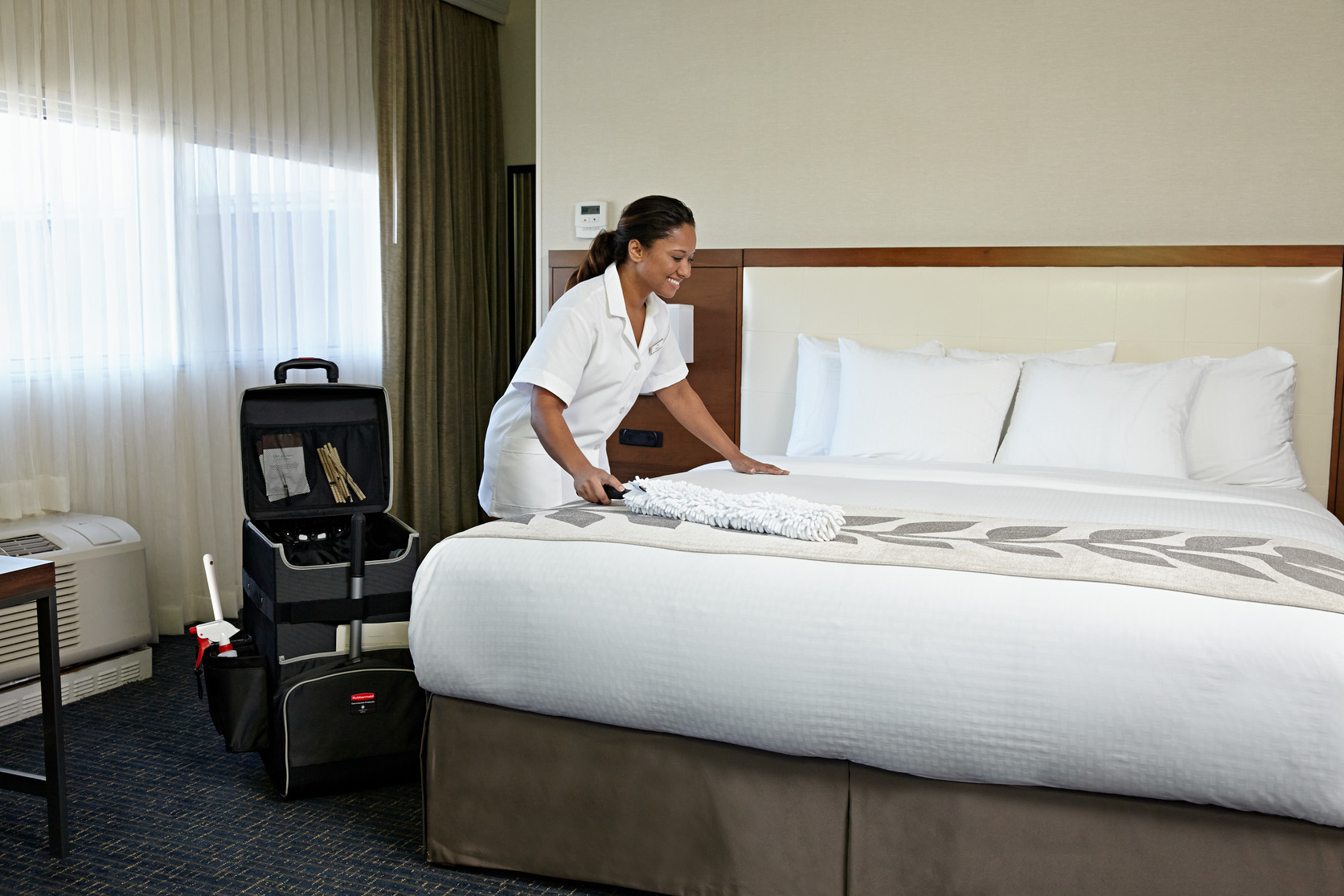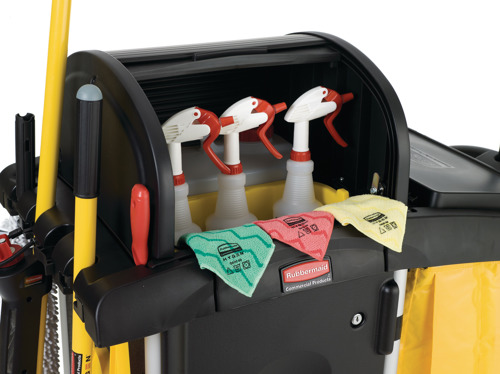
It goes without saying that maintaining a clean and hygienic space is crucial in all environments, especially in hospitality, facility management, and healthcare. While cleaning tackles visible dirt and grime, sanitisation goes a step further, targeting harmful germs, viruses, and bacteria that can pose serious health risks. Effective sanitisation solutions and methods, such as using chlorine and bleach, are key to protecting everyone who walks through your doors.
In this article, we'll explore why sanitisation is so important, how it differs from cleaning, and the best ways to use chemical sanitisers. We'll also provide a recommended cleaning checklist to ensure thorough and effective hygiene practices. By mastering these practices, you'll ensure your spaces, especially in hospitality settings, are not just clean but truly safe and healthy for all.
The Difference Between Cleaning and Sanitisation
Sanitisation is the process of sterilising surfaces to eliminate harmful germs, viruses and bacteria. Unlike cleaning — which focuses on removing dirt, dust and debris — sanitisation aims to reduce pathogens to a safe level. This is crucial in hospitality and other public settings, where surfaces can harbour bacteria that pose health risks. For example, high-touch areas like door handles and communal spaces require regular sanitisation to prevent the spread of infectious diseases.
Sanitising is essential because it goes beyond mere cleanliness, ensuring that surfaces are hygienic and safe for guests and visitors. Using effective sanitisation solutions and methods — such as chemical sanitisers like chlorine and alcohol — can significantly reduce the presence of harmful microorganisms. In busy environments like restaurants, hotels and healthcare environments, maintaining high hygiene standards is vital to protect patrons and staff from potential health hazards.
Cleaning Eradicates Germ-Harbouring Materials
Materials such as dust, dirt and debris can harbour bacteria, causing them to spread quickly and placing hospitality venues at risk. On top of this, certain hospitality businesses may also be more susceptible to specific types of visible, bacteria-harbouring dirt.
For example, a restaurant that has just finished serving peak-hour customers may have traces of food matter on benches and across the floor. Similarly, a wedding function hall will see plenty of customers, meaning their bathrooms may become soiled with waste and faecal matter much quicker than another hospitality business.
Public spaces, especially those with high foot traffic, are particularly vulnerable. Regular routine cleaning and deep cleaning sessions are essential to prevent the accumulation of dirt and the growth of harmful germs.
The physical cleanliness of a business premise isn’t always an indication of its ability to meet all sanitisation requirements. However, the cleaner a surface is, the more effective all disinfecting protocols will be. So hospitality owners and workers must take all the precautions to clean before they enforce disinfection. Using a cleaning checklist, like this hospitality-specific one by Rubbermaid, can ensure that all surfaces receive the attention they deserve.
It’s important to remember that bench surfaces should be cleaned before the floor to prevent accidentally recontaminating the ground with fallen debris. In addition, all brooms, mops, cloths and cleaning materials must be washed to ensure they don’t become a breeding ground for bacteria. Utilising proper cleaning methods and ensuring the safety of cleaning agents by referencing a safety data sheet can further enhance the effectiveness of cleaning protocols.
Sanitising Kills Bacteria And Makes Surfaces Hygienic
While cleaning is vital for hospitality businesses, sanitisation shares equal importance. Through the use of chemicals and heat, sanitising focuses on killing bacteria. It can make hospitality venues safer for patrons and allow them to use a business's services freely, without the risk of falling ill.
Effective sanitisation processes can remove all forms of bacteria from surfaces. This includes those travelling through the air and those coming from food, such as the deadly salmonella virus. As such, sanitisation plays a role in all hospitality businesses, but only when completed after cleaning. This will guarantee the sanitiser can reach the surface and does not miss any bacteria hidden under debris.
Although many effective sanitiser solutions can eradicate bacteria, the team at Rubbermaid highly recommends that hospitality business owners consider their surroundings. For example, a business servicing children would need to use a child-safe cleaner, whereas one working with food should ensure they are using products that won’t contaminate ingredients.
Rubbermaid’s Guide To Effective Cleaning And Sanitisation
Cleaning
In addition to a cleaning schedule and checklist, specific cleaning resources can ensure that dirt and debris are removed effectively. When cleaning floor surfaces, using a Vinyl-Coated Angle Broom can guarantee that sweeping is easy and that all dirt is picked up. When working on surfaces, pick up all large debris while wearing gloves. Clean spills or hard-to-grasp dirt with a HYGEN microfibre cloth.
Sanitisation
The Rubbermaid team understands that sanitisation can be difficult for hospitality businesses, especially those without the proper training and resources. To help business owners and staff understand their due diligence in keeping the premises safe, hygienic and free from infections, the team has many online resources. The Hospitality Industry Insights available on the Rubbermaid website provide a detailed guide on choosing the right sanitisation equipment. Following this guide can help business owners ensure a deep clean and sanitisation every time.
Whether cleaners use launderable microfibre or HYGEN microfibre mops, they must pay attention to sanitise the entire surface. Curved surfaces and the flooring underneath equipment are often missed and can promote the spread of bacteria. In a worst-case scenario where they are frequently left unsanitised, they can also lure pests, such as flies.
For businesses operating across large hospitality spaces, including hotels, casinos or sports stadiums, it's recommended that cleaning staff are provided with cleaning carts to ensure that all sanitisation resources remain infection-free. This is especially important if cleaning is executed while crowds visit the venue, as patrons could accidentally spread airborne infections onto cleaning materials.
Rubbermaid Helps Keep The Hospitality Space Clean
Passionate about sourcing and creating the best-quality cleaning and sanitisation tools on the market, Rubbermaid is a one-stop shop for business owners looking to keep their hospitality venue free from bacteria. If you are seeking a way to better clean and disinfect your premises, the team at Rubbermaid is always happy to help.
Contact us today to learn more about which solutions best suit your premise. You can also browse Rubbermaid Commercial Cleaning product lines here.